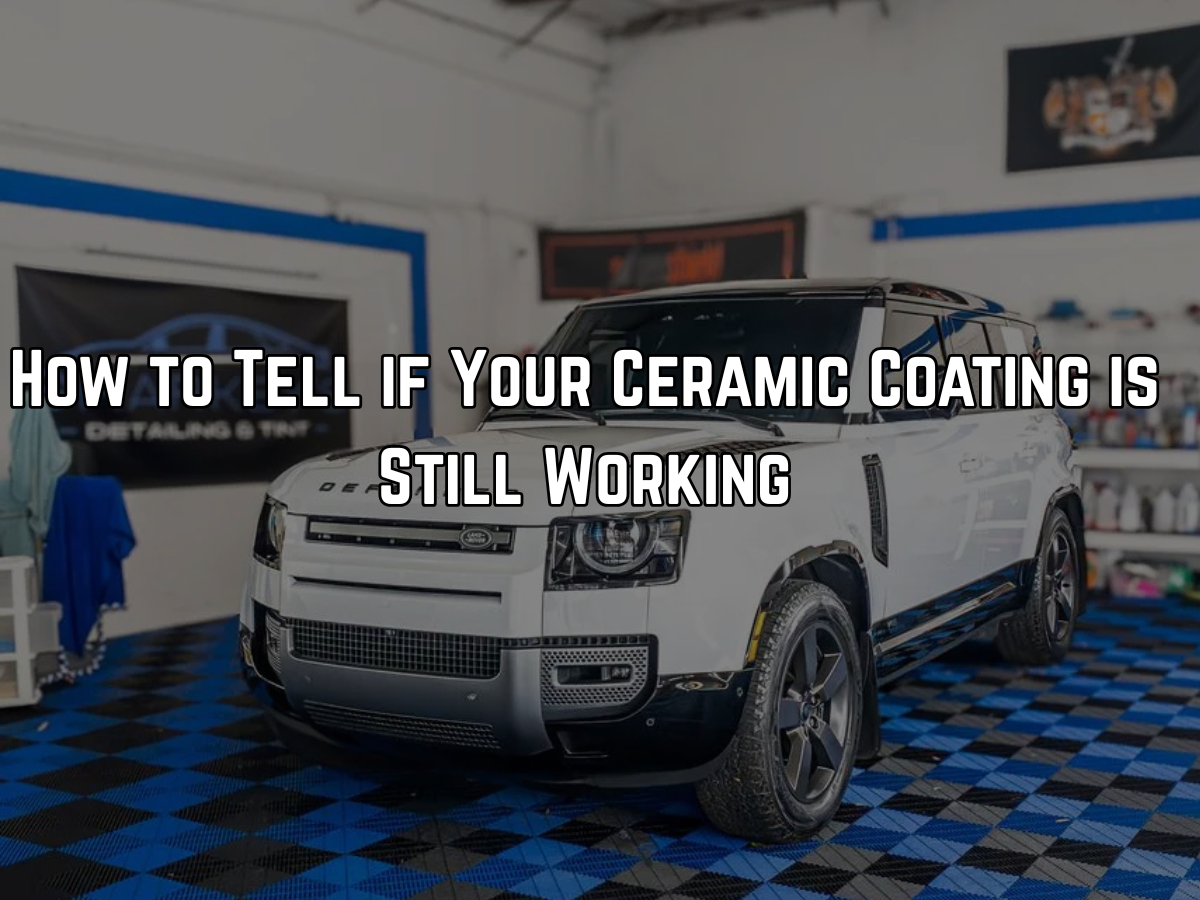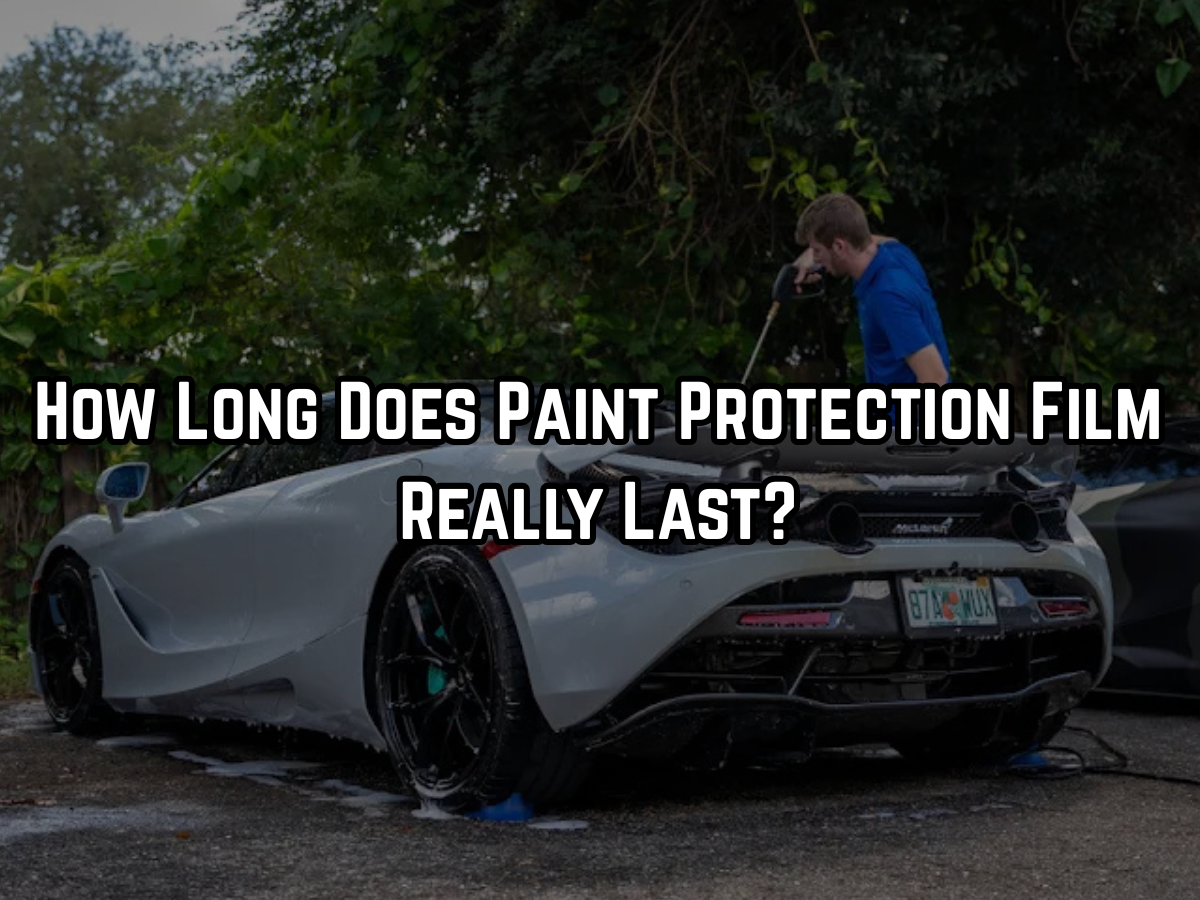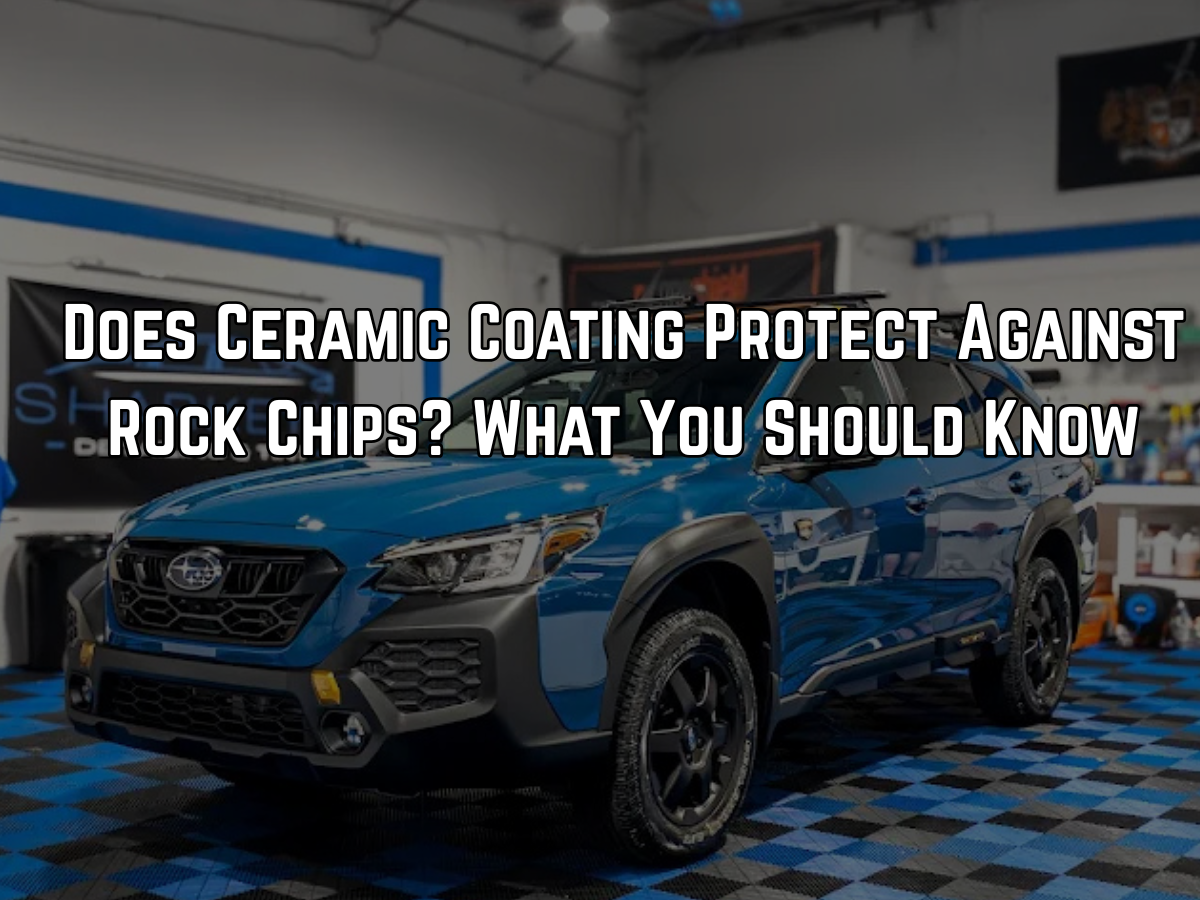How to Tell if Your Ceramic Coating is Still Working
You invested in a ceramic coating months or maybe years ago. The installer promised it would last 2 to 5 years, maybe longer. But lately, you're wondering: is it actually still working, or are you just washing a regular clear coat at this point?
Quick Answer: You can tell your ceramic coating is still working if water beads up tightly and sheets off easily, dirt wipes away with minimal effort, your paint maintains its gloss without polishing, and contaminants don't stick aggressively. If water spreads flat, dirt clings stubbornly, or your paint looks dull despite washing, your coating has likely degraded.

The Water Beading Test
This is the most obvious check, and honestly, the one most people know about. But there's more to it than just "does water bead?"
A functioning ceramic coating creates tight, defined water beads. We're talking about beads that sit high on the surface with steep contact angles, usually 100 to 110 degrees or more. When you spray water on your paint, it should form distinct droplets that roll off easily.
Here's what to watch for: the beads should be round and compact, not flat and spread out. If water is sheeting in wide, thin layers or sitting flat on the surface, your coating's hydrophobic properties have broken down. That's your clear coat showing through.
Some coatings change their beading behavior as they age. They might shift from tight beading to more of a sheeting action where water slides off in smooth sheets. That's actually fine. It's still working. The problem is when water just sits there doing nothing.
How Dirt and Grime Behave
A working ceramic coating makes dirt removal almost too easy. When you wash your car, contamination should release without much scrubbing. The self-cleaning effect means that dirt, dust, and light grime don't bond to the surface aggressively.
Try this: after a rain or a dusty day, run your finger across your paint. If there's a thick layer of crud that's really stuck on there, your coating might be compromised. A functioning coating keeps that stuff sitting on top rather than bonding to the clear coat.
Bird droppings are another test. Not that anyone wants those on their car, but they happen. With a good coating, you can usually spray them off with a hose or wipe them away with a damp microfiber towel. If bird droppings are etching into your paint or becoming impossible to remove without serious scrubbing, that's a red flag.
Gloss Retention Over Time
Ceramic coatings enhance and maintain gloss. Your paint should look deep, reflective, and wet even when it's bone dry. If you're noticing that your car looks dull or flat, especially after a fresh wash, the coating has probably lost its effectiveness.
Compare your paint's appearance to photos from right after the coating was applied. I know not everyone takes before and after shots, but if you have them, they're helpful. The gloss should be nearly identical if the coating is still intact.
Sun exposure matters here too. Florida's UV rays are brutal on everything, coatings included. Cars parked outside 24/7 will see faster degradation than garaged vehicles. But a quality coating should still maintain most of its gloss for at least 2 to 3 years, even with full sun exposure.
The Touch Test
Run your hand across your paint after washing and drying it. A working ceramic coating feels slick, almost like touching glass with a tiny bit of oil on it. There's a smoothness that's different from bare clear coat.
If your paint feels rough or textured, that could mean contamination is bonding to the surface, which shouldn't happen easily with a functioning coating. Now, some roughness is normal in certain environments. Industrial fallout and rail dust can affect even the best coatings. But if contamination is building up quickly after each wash, your coating isn't providing the protection it should.
The slickness test works best when your paint is completely clean. Wash and dry your car, then feel different panels. The hood, roof, and trunk should all feel consistently smooth and slippery.
Chemical Resistance Signs
Ceramic coatings are supposed to resist chemicals. Bug splatter, tree sap, bird droppings, and road tar should sit on top of the coating rather than bonding to or staining your clear coat.
If you're finding that bugs are becoming harder to remove, or tree sap is leaving permanent marks, your coating's chemical resistance has declined. A healthy coating lets you wipe these contaminants away within a day or two without any staining or etching.
Road salt is another indicator, especially relevant in coastal areas like Sarasota. Salt spray and salt residue should rinse off easily with a coating. If you're seeing salt buildup that requires scrubbing or if salt is leaving white stains, that's a sign of coating failure.
Maintenance History Matters
How you've maintained your coating directly impacts how long it lasts. Coatings need proper care to reach their full lifespan.
- Washing frequency plays a role. Washing every 2 weeks keeps contaminants from sitting on the coating long enough to degrade it. Letting dirt and grime build up for months creates more wear.
- Wash method matters too. Using pH-neutral car shampoo preserves the coating. Harsh detergents, dish soap, or automatic car washes with strong chemicals break down the coating faster. If you've been using questionable products, that explains why your coating isn't performing.
- Topper products extend coating life. Some coatings benefit from spray sealants or boosters applied every 3 to 6 months. These products refresh the hydrophobic properties and add an extra layer of protection. If you haven't used any toppers and it's been 2 or more years, your coating might be hanging on by a thread.

Understanding Coating Lifespan Claims
When installers say a coating lasts 5 years, they're talking about ideal conditions. That means the car is garaged, washed properly every 2 weeks with appropriate products, topped up with boosters regularly, and not exposed to extreme contamination or abuse.
Real world conditions rarely match that scenario. Most coatings realistically last 2 to 4 years with normal use and decent maintenance. Some high-end coatings do push past 5 years, but they're the exception.
If you're at the 3 year mark and noticing declining performance, that's pretty standard. The coating has served its purpose and is now in its final phase. You can extend it a bit with careful maintenance, but eventually, it'll need reapplication.
What Happens When Coatings Fail
Ceramic coatings don't just disappear overnight. They degrade gradually. The first thing to go is usually the hydrophobic layer. Water beading decreases, but the coating might still provide some gloss enhancement and light protection.
Next, the chemical resistance drops. Contaminants start bonding more aggressively. You'll notice tree sap leaving marks or bird droppings etching faster than they used to.
Finally, the coating becomes so thin and degraded that it's essentially gone. At this point, you're back to bare clear coat with maybe some microscopic coating remnants. Your paint behaves exactly like an uncoated car.
Some coatings develop high spots or uneven areas as they age. You might see water beading normally in some areas but not others. That's partial coating failure, usually caused by uneven wear or damage to specific panels.
The Panel-by-Panel Check
Not all panels degrade at the same rate. The hood gets the most abuse from bugs, rocks, and sun exposure. It's often the first panel to show coating failure. The roof takes heavy UV damage but less physical impact.
Check each major panel individually:
- The hood should still bead water well if the coating is working. This panel faces the most contamination, so if it's still performing here, you're in good shape.
- The roof often maintains its coating longest because it gets less direct impact from road debris. But UV degradation shows up here first as reduced gloss.
- Doors and fenders get hit with wheel spray, brake dust, and road salt. Check how easily these areas clean up. Stubborn brake dust that won't rinse off suggests coating failure.
- The trunk and rear bumper catch exhaust residue and road grime. If this area is significantly harder to clean than the rest of the car, the coating might be gone here while still functioning elsewhere.
When to Consider Reapplication
If you're seeing multiple signs of coating failure across most panels, it's time to think about reapplication. A coating that's 80% gone isn't really protecting your paint anymore.
Before jumping to reapplication though, try a coating booster or topper product. Sometimes what looks like coating failure is just a dirty or contaminated coating. A thorough wash followed by a topper application can bring back beading and slickness.
If toppers don't help, and you're still seeing poor water behavior and increased contamination bonding, the coating is done. Getting a new coating applied means going through paint decontamination and possibly light paint correction to remove any embedded contamination and prepare the surface.
Testing After Professional Maintenance
If you've recently had ceramic coating maintenance done, your coating should perform like it's nearly new. Professional maintenance includes decontamination, coating inspection, and often application of a topper or booster.
After professional maintenance, expect to see:
- Strong water beading returning
- Enhanced gloss and depth
- Easier cleaning during washes
- Better contamination resistance
If these improvements don't show up after professional maintenance, the coating might be too degraded to save. That's when you're looking at full reapplication rather than maintenance.
Environmental Factors in Sarasota
Florida's climate tests ceramic coatings hard. The combination of intense UV exposure, high humidity, salt air, and frequent rain creates challenging conditions.
Salt air accelerates coating degradation, especially on cars parked near the coast. The salt deposits can break down the coating's chemical structure faster than in dry, inland climates.
UV intensity in Florida is among the highest in the country. This constant sun exposure breaks down the polymer bonds in ceramic coatings over time. Expect slightly shorter coating lifespans compared to what owners in northern states experience.
Heavy rain and humidity actually help in one way. They keep your car washed more frequently, preventing contamination buildup. But the moisture also means more water spotting if you have hard water, which can etch into weakened coatings.
Simple Weekly Check Routine
You don't need to do a full inspection constantly. A quick weekly check tells you what you need to know:
Spray one panel with water from a hose. Watch how the water behaves. Tight beading or smooth sheeting means the coating is working. Flat, spread out water means trouble.
That's it. Takes 30 seconds. Do this weekly and you'll catch coating degradation early rather than discovering it's been gone for months.
Making Your Coating Last Longer
Proper maintenance extends coating life significantly. Wash every 2 weeks with pH-neutral shampoo. Avoid automatic car washes with harsh chemicals or brushes.
Apply a coating topper every 3 to 4 months. These products are simple spray-on treatments that take 15 minutes and refresh the hydrophobic layer.
Park in shade when possible. Even a carport makes a difference in coating longevity compared to full sun exposure all day.
Address contamination quickly. Don't let bird droppings, tree sap, or bug splatter sit for days. The longer they sit, the more they degrade the coating.
Bottom Line on Coating Performance
Your coating is either working or it's not. The signs are pretty clear once you know what to look for. Strong water behavior, easy cleaning, maintained gloss, and contamination resistance mean you're good. Poor water behavior, difficult cleaning, dull appearance, and aggressive contamination bonding mean your coating is done or nearly done.
Most coatings genuinely perform for 2 to 4 years with proper care. If you're in that window and seeing good signs, keep up your maintenance routine. If you're seeing failure signs, decide whether topper products might help or if it's time for reapplication.
Check your coating regularly, maintain it properly, and you'll get every bit of protection and performance it can provide. For professional assessment of your coating's condition or information about ceramic coating services, expert help is available to evaluate what your coating needs.




